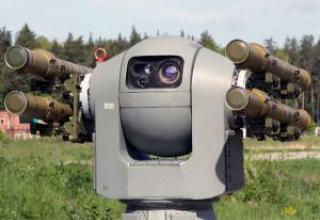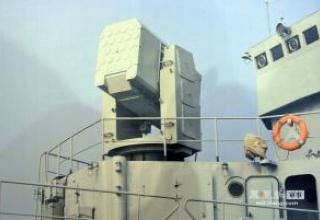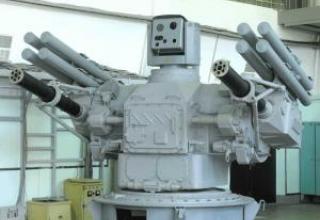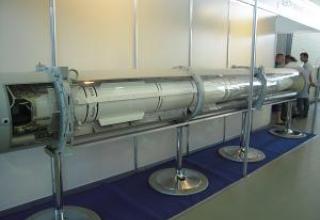American rockets Standard is a family of solid-fuel guided missiles, class "ship - air", designed to protect ships from air strikes at medium (20 to 100 km) and long (over 100 km) ranges.
Initially, the Standard series appeared as a concept to replace the anti-aircraft missiles short-range RIM-24 Tartar and medium-range RIM-2 Terrier single modern missile, which could use existing fire control systems and launchers.
The development of the RIM-2 Terrier was initiated in 1963 by General Dynamics Corporation and is currently being conducted by Raytheon. They were designed to minimize the amount of new elements introduced into the control systems, to utilize existing launchers, and to use existing ship storage and recharging systems.
The creation of the SSAM Standard resulted in the reduction of the large number of obsolete anti-aircraft missiles in service with the U.S. Navy at the time and the standardization of medium- and long-range ship-based anti-aircraft missile weapons.
Scheme of the Standard missile family development
(for detailed information on the product, click on its designation in the diagram).

Composition:
Standard SM-1
The SM-1 (Standart Missle 1) anti-aircraft guided missile was based on the latest modifications of the Tartar RIM-24 missile, including the Mk27 engine with two thrust stages and the 62-kg Mk51 rotor combat unit. The SM-1 was equipped with conical radar CNS.
Unlike its predecessors, the missile was distinguished by the use of semiconductor electronics, electric drives of the rocket rudders (instead of hydraulic) and the presence of a battery as a power source.
All this ensured increased reliability and speed of response to commands.
SM-1MR
RIM-66 SM-1MR (Medium Range) missiles were intended to replace RIM-24 Tartar.
Tests of the missile YRIM 66A began in 1965, and in 1967, the anti-aircraft guided missile RIM 66A (SM-1MR Block I) came into service.
Small improvements resulted in modifications of Block II, III and IV, characterized mainly by the sensitivity of the CNS, resistance to radio interference, of which the latter was the last in the series since 1968, with a wider range of capabilities to overcome interference and a reduced minimum range.
The SM-1 rocket family (the first production series) requires radar illumination of the target throughout the flight, from launch to engagement.
RIM-66 SM-1MR Modifications
The entire RIM-66 SM-1MR family was originally designed to replace the RIM-24 Tartar SAM system using its fire control and launch systems. Subsequently, after the appearance of the AEGIS system and vertical launchers, a number of modifications were developed, adapted to the new complexes.
- RIM-66A is a basic version of a medium-range missile.
- RIM-66B (SM-1MR Block V) - The missile was equipped with a flat scanned CNS and autopilot with a faster response, as well as a new shrapnel-array warhead (Mk 90) and two-stage propulsion engine (Aerojet Mk 56). The radius of action increased to 46 km.
- RIM-66E - the last version, designated as SM-1MR Block VI, entered service in 1983. It was developed after the C and D versions, designated as SM-2, and borrowed a number of elements from them - including monopulse CNS and a new warhead.
- It was intended mainly for export to countries that could not afford to buy more expensive SM-2s. There are several configurations of Block VI (RIM-66E-1/3/5/6/8) that have entered service. Configurations 3/8 are equipped with SM-2 combat unit (Mk115). Block VI A (RIM-66E-5) and Block VI B (RIM-66E-6) are equipped with the latest modifications of the Mk45 fuse and the Mk115 combat unit.
- RGM-66D SSM-ARM (Surface-to-Surface Missile/Anti-Radiation Missile) is a version of RIM-66B designed to engage surface targets. It was equipped with a passive homing unit instead of a semi-active one.
- This modification could be used for attacks on enemy ground radars or on warships with switched on radars. The missile could "memorize" the target location and hit it even if the radar was turned off. The ballistic trajectory radius was 60 km.
- RGM-66E is a version of the RGM-66D designed to be launched from anti-submarine launchers of the RUR-5 ASROC complex. The missile was placed in the launch cell instead of an anti-submarine torpedo missile.
- RGM-66F - developed version of the missile, equipped with an active homing head. It was intended for over-the-horizon use against enemy warships (the project was closed in 1975).
- AGM-78A - aircraft anti-location missile, developed on the basis of SM 1, was equipped with a new engine Aerojet Mk27.
- AGM-78B - an aircraft anti-location missile developed on the basis of AGM-66A, was supplemented by a homing projectile of Maxson company, operating in a wide range.
- AGM-78C - a variant of AGM-66B missile, created in the period from 1970 to 1972. It had a reduced production cost and higher reliability.
- AGM-78D - the final version of the Standard ARM, was created in the period from 1973 to 1976, and was equipped with an Mk69 engine. It featured a high reliability, active optical fuse and a new 100-pound combat unit.
SM-1ER
RIM-67 SM-1ER (Extended Range) missiles were designed to replace the RIM-2 Terrier. Terrier launchers and SAM systems were used.
RIM-67 SM-1ER Modifications
- RIM-67A is the first long-range missile in the Standart family. It was a two-stage rocket, the first stage of which was the launch accelerator Hercules Mk12, the second stage was based on SM-1MR Block V (was equipped with a marching engine Atlantic Research Corp. Mk30).
- Two models of these missiles were developed, the main difference being the use of different marching engines by Atlantic Research Corp. The first model uses the Mk20 engine, while the second model uses the more economical Mk30 engine.
Production of Standart-1ERs was discontinued in 1973, and they are now removed from service with the U.S. Navy ships.
- see on our website:
- Standard-1 anti-aircraft guided missile
- Standard-ARM (AGM-78) antiradar missile
Standard SM-2
SAM SM-2 (RIM-66C) is similar to RIM-66B, but has a combined guidance system and an Mk115 combat unit. It is equipped with a semi-active monopulse radar self-direction head for the final target area (accompanied by a radar beam only for precise aiming at the moment of an attack), a new inertial guidance unit and a programmable autopilot Mk2, which controls the missile's flight on the marching section of the trajectory (with the possibility of updating the data on the middle section of the trajectory) to lead to the point of planned intercept. The missile was developed for use in the AEGIS air defense system.
Unlike the SM-1MR, the SM-2MR does not require flight path corrections and follows a more optimal trajectory. The first SM-2MR Block I missiles entered service in 1978 under the designation RIM-66C for ships with AEGIS system and RIM-66D for ships without AEGIS system.
In 1983, the SM-2MR Block II antiaircraft guided missile with a new fragmentation warhead and an upgraded propulsion system (Thiokol Mk104) was adopted for service, which almost doubled the intercept range.
SM-2MR Block III, which entered service in 1988, is equipped with an advanced non-contact fuse and combined radar infrared CNS.
RIM-66 SM-2MR Modifications
- RIM-66C is the first version of the missile, designated SM-2.
- RIM-66D is a version of RIM-66C for ships with Tartar LSS. Distinguished by the design of the autopilot, programmable immediately before launch (as the Tartar LSS could not provide correction of the missile in flight).
- RIM-66G - rocket with a new engine Thiokol Mk104, which had an extended range of more than 120 km and increased flight speed. It was designed for AEGIS PLC and Mk26 beam launchers.
- RIM-66H is a version of the RIM-66G missile adapted for launch from the Mk41 vertical launcher and AEGIS ISS.
- RIM-66J is a version of RIM-66G adapted for the Tartar LSS.
- RIM-66K (SM-2MR Block III) - the last modification of the missile. Designed to provide better engagement of low-flying anti-ship cruise missiles. Had an improved guidance system K 45 MOD 9, which allowed a better understanding of targets against the surface. Block III A was equipped with a new combat unit Mk125, and Block III B was equipped with a combined semi-active infrared CNS, which allows the missile to better perform the selection of false targets and provides the ability to shoot for the radio horizon.
- RIM-66L is a version of the RIM-66K missile for the AEGIS ISS and Mk26 beam launchers.
- RIM-66M - version of RIM-66K for AEGIS LSS and Mk41 HPU.
RIM-67 SM-2ER Modifications
The RIM-67 SM-2ER family was an ideological continuation of RIM-67A. SM-2E was based on SM-2MR Block I/II/III missiles. Launch systems and Terrier SAM systems were used. Modification for AEGIS system was not created.
- RIM-67B (SM-2ER Block I) - an improved version of RIM-67A, which had an inertial control system on the march section and a new monopulse locator CNS.
- RIM-67C (SM-2ER Block II) - the Mk12 accelerator was replaced by a new Mk70 accelerator that increased the radius to almost 150 km.
- RIM-67D (SM-2ER Block III) - version with guidance system Mk45 MOD 8 TDD.
RIM-156 SM-2ER Modifications
The RIM-156 (SM-2ER Block IV) missile is a modification of the RIM-67 series, which was undertaken to adapt the missile to the AEGIS control system and the Mk-41 HPU. It was developed in the late 1990s, in connection with the earlier write-off of the vast majority of old ships with Terrier control systems.
- RIM-156A - basic version, adopted in 1999. It had a new accelerator Mk72, adapted to launch a missile from the Mk41 HPU. The steering wheels and ailerons were also modified to make the missile more easily placed in the launchers. The new guidance system Mk45 MOD 10 TDD improved the missile's ability to engage low-speed targets under the conditions of the airborne radar.
- RIM-156B (SM-2ER Block IV A) - version of the missile with a new radar/infrared guidance system, which provides an improved ability to select false targets and the ability to fire low-flying missiles over the horizon. The first missile in the Standard family to be capable of intercepting ballistic targets under the Navy Area Theater Ballistic Missile Defense programme. Successfully proved itself in the tests, but due to the cancellation of the entire program was never adopted. Currently, all RIM-156 missiles are replaced by the new SM-6, with a range of up to 240 kilometers and active radar guidance.
- see on our website: Standard-2 anti-aircraft guided missile.
Standard SM-3
ZUR SM-3 (RIM-161) was created on the basis of SM-2ER Block IV A and added a third stage engine (Advanced Solid Axial Starge - ASAS created in Alliant Techsystems), a new GPS / INS system and a new kinetic combat unit LEAP (Lightweight Exo-Atmospheric Projectile).
The ship-based missile defense system is based on the upgraded Aegis multifunction combat control system. This system is equipped with destroyers like Arleigh Burke and Zumwalt, part of the U.S. Navy Ticonderoga cruisers. SM-3 missiles under Aegis control are also deployed on ships of similar purpose of the Japanese Navy (Kongo class destroyers), Spain (F100 class frigates), South Korea (KDX-3 class destroyers), Australia and Norway (F-314 type frigates).
The first test run of SM-3 took place on September 24, 1999. The SM-3 upgrade work began even before the start of the tests and is still ongoing. The main stages of modernization and prospective development of the missile were designated SM-3 Block IA, SM-3 Block IB, SM-3 Block IIA, SM-3 Block IIB.
In parallel with the modernization of the missile itself, active work is underway to integrate SM-3 with other combat control and detection systems.
Prospective Aegis BMD 5.1 will be able to use all missiles of the Standard family and have the ability to intercept intercontinental ballistic missiles. Aegis BMD 5.1 will be put into service after 2020.
RIM-161 SM-3 Modifications
- RIM-161A (SM-3 Block I) - basic version of the missile used to test the concept.
- RIM-161B (SM-3 Block IA) with the Aegis BMD 3.6.1. system is a reduced-cost serial missile equipped with modified control equipment (flight tests of SM-3 Block IA started on June 22, 2006, during which a number of successful ballistic target intercepts were performed at different parts of the trajectory).
- RIM-161C (SM-3 Block IB) with the Aegis BMD 4.0.1 system is a modified version of the missile with dual-band infrared CNS, enhanced target distribution capabilities, and a modified third stage engine (capable of changing the thrust value), which allows the missile to more effectively engage maneuvering targets. The first test was conducted in May 2012.
- RIM-161D (SM-3 Block II) - an improved version of the missile under development. It is a completely new missile with a body diameter of 530 millimeters. The missile has a longer range and higher speed.
- SM-3 Block IIA is a version of the missile with a new enlarged kinetic interceptor and new sensor equipment, with enhanced false target filtering capabilities. It is designed to provide the fleet with the capability to intercept intercontinental ballistic missiles. The missiles are equipped with an oversized intercept stage, an improved ICGSN and a more efficient TDACS (Throttleable Divert and Attitude Control System) kinetic warhead propulsion system.
According to press reports, as of 2016, a modified SM-3 Block IIB missile is under development. There is no information on the characteristics of the missile in the public domain, but it is known that one of the tasks set for the developers is a more confident destruction of intercontinental ballistic missiles.
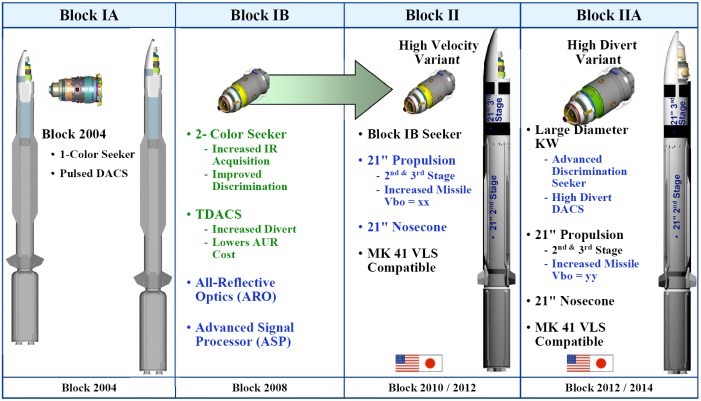
- see our website: Standard-3 anti-aircraft guided missile (SM-3/ RIM-161).
Standard SM-4 LASM
Unaccepted version of the missile designed to fire ground targets. Described as RGM-165 LASM (Land-Attack Standard Missile), the missile was equipped with the Mk115 combat unit borrowed from SM-2MR Block II / III, the Mk104 rocket engine and inertial guidance combined with GPS guidance. The Navy intended to use the missile as a replacement for heavy naval artillery, to bombard the coast and support the Marine Corps, hitting fortifications, crowded enemy forces and defensive positions.
Although the tests were successful, the Navy refused to accept the missile due to its inability to hit well protected or moving targets.
Standard SM-5.
The project of a new generation anti-aircraft missile equipped with an active homing radar head with the possibility of external target designation. Re-launched as SM-6.
Standard SM-6
-
RIM-174 SM-6 ERAM (Extended Range Active Missile) is a development of the family of missiles RIM-156. The main features of SM-6 that distinguish it from SM-2 are: a new larger diameter engine (Mk104), an upgraded control system with an active semi-active homing radar head and protected data line, an upgraded shrapnel-phase warhead (Mk125 - shrapnel-phase directional warhead is equipped with an improved fuse and optimized to hit low-fire targets). The range of the SM-6 is significantly extended.
The rocket is launched from Aegis Mk41 vertical launchers.
- see our website: SM-6 anti-aircraft guided missile (RIM-174 Standard ERAM).
Characteristics:
| Feature | SM-1MR | SM-1ER | AGM-78 | SM-2 MR | SM-2 ER | RGM-165 | SM-3 | SM-6 |
| Number of steps | 1 | 2 | 1 | 2 | 1 | 3 | 2 | |
| Length | 4.41 | 7.98 | 4.57 | 4.72 | 7.98 | 4.72 | 6.55 | |
| Wingspan | 1,08 | 1.57 | 1,08 | 1.57 | 1,08 | 1.57 | ||
| Maximum diameter | 0.343 | 0.45 | 0.343 | 0.45 | 0.343 | 0.53 | ||
| Weight | 642.3 | 1343.6 | 620 | 642.3 | 1343.6 | 620 | 1501 | 1500 9 |
| Speed | 1032 | 738 | 1032 | 2600 | 1032 | |||
| Ceiling | 19800 | 24400 | - | 24400 | 24700 | 33000 | ||
| Firing range | 27.8-37.1 | 64 | 90 | 74 | 185 | 280 | 500 | 240 |
| Accelerator block | - | Hercules Mk12 | - | Hercules Mk70 | - | United Techologies Mk72 | ||
| Marshal engine | Aerojet Mk27 | Atlantic Research Mk30 | Aerojet Mk27 | Aerojet Mk56/ Thiokol Mk104 | Atlantic Research Corp. Mk30 | Thiokol Mk104 | Atlantic Research Corp. Mk104 | |
| Stage 3 engine | - | Alliant Techsystem Mk136 | - | |||||
| Fighting unit | Mk51/Mk90 | Mk51 | 777 | Mk115 | Mk125 | KW | Mk125 | |
Testing:
On July 3, 1988 the American cruiser Vincennes (CG-49) with two SM-2MR missiles shot down the Iranian civilian airliner Airbus A300B2.
On October 12, 2016, the USS DDG-87 Mason destroyer used two SM-2MR missiles and one ESSM to repel an attack by anti-ship missiles launched from Yemen.
On February 21, 2008, the SM-3 missile was launched from the Lake Erie cruiser in the Pacific Ocean and hit the 247-kilometer altitude USA-193 emergency reconnaissance satellite three minutes after launch.
According to the U.S. plans to create a European missile defense system (EuroPRO), SM-3 Block IIA missiles were planned to be deployed in Europe in 2015, and SM-3 Block IIB - after 2020.
Currently, according to the contract concluded in October 2013, about 89 SM-6 missiles of the first serial batch have been produced; in total, more than 130 missiles, counting pre-production prototypes. The plan provides for the production of 1,200 missiles, at a price of 4.3 million dollars per unit. It is expected that warships of the US, Japan, the Republic of Korea and Australia will be equipped with such missiles.
According to USNI News, the target interception test using SM-3 Block IIA in outer space was carried out on February 3, 2017. The test resulted in successful interception of the target ballistic missile.


